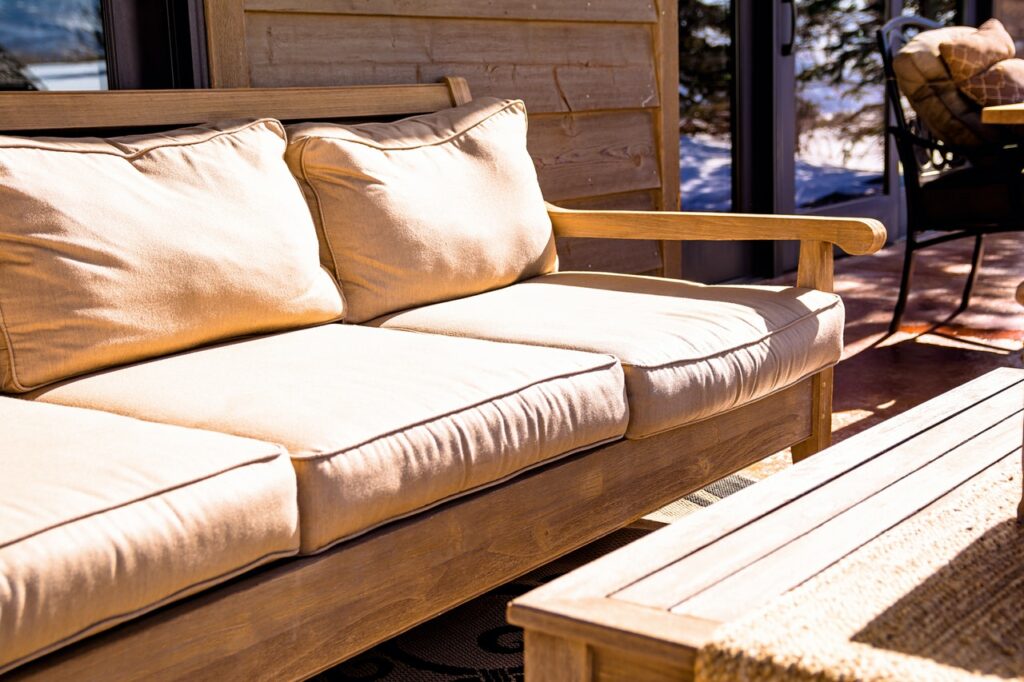Ideally, your backyard patio is like an extension of your living space, just another room of your home. You want it to feel comfortable and inviting and to not have to think twice about having this space look and feel nice to relax in or host guests. However, unlike your indoor furniture, your outdoor decor is subject to a lot more abuse beyond the regular wear and tear.
While patio furniture is designed to be much more hardy and more durable than regular furniture, this does not mean that it is indestructible or impervious to any damages. Like anything you own, if you want to get as much use out of your patio furniture as possible, you have to take good care of it over the years. Luckily, maintenance of your patio furniture is not too difficult or time-consuming, and you can ensure your outdoor pieces last for many years to come with these few simple steps.
Take Care of The Finish
All patio furniture is designed to hold up in an outdoor environment, but the type of material you choose for it can determine in part just how well it keeps over time. Keep in mind that different materials work better for different climates, so if you do not want to be replacing your patio furniture much more frequently and you are flexible with the aesthetic, choose a type that will withstand the climate conditions where you live. Refinishing your furniture every now and then will go a long way towards maintaining its original quality and look.
- Wood: For wood furniture, it is important that water does not seep into the wood and damage or warp it or causing rotting over time. If you notice you wood furniture could use a new coat of protection, you should first sand all exposed surfaces to get rid of any splintering edges. Next, apply a fresh coat of varnish to make your pieces look as good as new. You could even paint it a new color if you want to change up your look. For bigger cracks and holes, use a wood filler.
- Plastic: You should frequently clean plastic furnishings with soapy water and wipe it down with a soft, non-abrasive cloth. If your plastics need a fresh coat of paint, make sure you use a special paint with a strong bond that is made for adhering to this type of material.
- Wicker: Use a microfiber cloth to remove dirt and dust from your wicker pieces often. When your pieces need more of a deep clean, you can use soapy water and scrub it with a nylon brush. Rinse it with fresh water, preferably a hose with a strong stream, and always allow it to dry completely in a bright, sunny spot. Touch up the finish as need with a wicker varnish or stain.
- Metal: Rust is easier to prevent than to remove, so try to take a proactive approach to protecting you metal furniture. At least once a year or at the beginning of the season, refinish your metal pieces with a primer or a wax. If you already have some small rust spots, there are plenty of commercial rust removal products available, or you can sandblast it back to life. Always repaint and finish any treated rust spots so that they do not come back.
Keep Your Fabrics Fresh
Many patio sets come with their own cushions or pillows made of fabric. While these materials are usually burlier than your average couch cushion and may be more resistant to stains, they are still designed to be soft and comfortable and need regular care. Wash or launder your fabrics regularly. If the fabric cover is removable, you can usually just machine wash it. If it is not, you can mix ¼ cup of mild dishwashing detergent with a gallon of warm water. Scrub the surface gently with a soft nylon brush, then allow the fabrics to dry fully in the sun.
Sometimes, the padding inside your cushions can become worn out over time. You do not necessarily have to buy new ones if you like the ones you already have and do not want to spend the extra money. You can have them restuffed or do it yourself with a little foam or batting from the hardware store. If you are unsure of the right material to refill your cushions with, many outdoor living retailers sell special pillow filler for outdoor use.
If you live in an area where you get many surprise summer showers, you may want to finish your fabrics with a protective finishing spray. This way, if you do not always remember or are unable to bring your cushions inside in time, they will be more resistant to water and mildew.
Store and Cover Your Furniture When Not in Use
If you live in a climate with a harsh winter season or cold weather, you should strongly consider storing your furniture inside before the season changes. It is harder for your patio furniture to accumulate weather damage if it is rarely exposed to bad weather. If you do not have room to store your pieces indoors, consider renting a storage space for the winter.
If you are bringing your items inside for the season, make sure that you thorough clean and touch up your pieces before putting them away in storage. You do not want to put away your patio furniture to protect it from damage for the season, only to find that rust spot or wood rot you neglected has made your beautiful furniture unusable when you go to put it out next season.
If possible, you should also try to store your patio furniture whenever some harsh weather conditions are in the forecast. Depending on the materials and age, your furniture may be able to stand up to some light rain, but a big storm could really do some damage. If you leave your wicker or wood furnishings out when there is flooding, this is a perfect recipe for mildew. Similarly, strong winds could blow your furniture around and damage it, or you could lose your cushions if they are not secured properly.
Many retailers also make special covers for your patio furniture to protect them between uses. You can use these covers for your pieces while they are in storage, or you can use them while your furniture is still out on the deck but not in use to shield it from dew and sun.
Arranging Your Furniture Outside
When your furniture is living outdoors, you should also consider where you place it. If you have a shade sail over your patio or big, shady tree, this can provide you with some additional sun protection. On the other hand, you will want to keep your furniture far away from certain trees. Nut trees, like hickory and oak, have oils in their bark that can stain your pieces. Nuts and acorns could also fall and dent your furniture. If you want to avoid bird droppings, do not place your pieces near or under trees with nests or bird houses.
With these simple tips, you can make sure that your make the most of your investment and that your patio furniture will last to provide you enjoyment for years to come.



